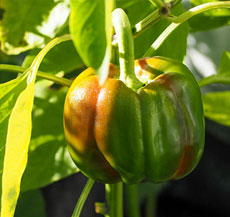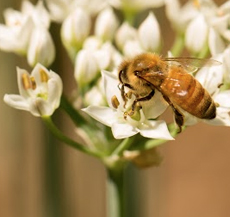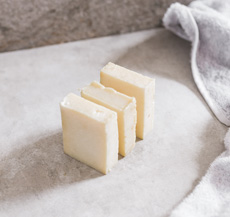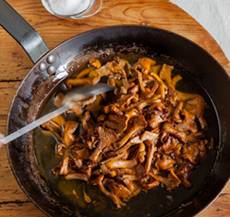Time to Jam
Summer is fruit season here in the Northwest, a glorious moment in time when we start to (literally) enjoy the fruits of our labors as a wide range of luscious, juicy berries ripen—from the organic Tulameen raspberries grown in our gardens to wild blackberries and sweet blueberries.
Our berries are lovingly hand-picked each morning during this season. Some go straight into our mouths for a delightful snack, others are destined for fresh fruit crisps. But, without fail, we also tuck away a supply for our housemade jam, which captures the wonderful, fresh flavors of summer for months to come. This month, it’s the juicy and ripe Tulameen raspberries that are headed for our jars.
The process is simple, with just a few quality ingredients included in our ‘uncooked’ recipe: organic fruit, organic sugar and pectin. That’s it. A quick stir and into the freezer it goes—and believe us, nothing beats pulling out a dollop in deep, dark winter to brighten up morning toast or to serve alongside freshly-baked scones.
Bee Happy
With the arrival of beautiful blooms and warmer temperatures, our native pollinators—namely the Orchard Mason bees and honey bees—are now busy, busy, busy collecting pollen and nectar. Here at the farm we help foster these bee communities in two separate ways:
First up, Mason Bees make their homes in tiny holes in tree trunks, reeds, natural small nooks, or in man-made structures like our new specialized Orchard Mason bee houses which were installed by Dave and Beth Richards of Woodinville’s JohnnyAppleBeez in sunny, south-facing spots here at the farm to help with crop pollination. These handmade cedar houses are filled with reed tubes that mimic the bees’ natural nesting spots. These busy, non-stinging bees are considered nature’s ‘super’ pollinators – pollinating up to more than eighty times as many flowers as honeybees do as they can work in cooler temperatures and start flying earlier in the spring, and are a welcome addition to the farm!
Then, the honey bees in our dedicated apiary are also abuzz with activity this spring, traveling from flower to flower to make honey to feed the brood in the hives. Honey bees form large organized colonies, or hives, usually in hollow tree trunks in the wild, which can contain as many as seventy-five thousand bees. The wooden bee hives we keep in the apiary usually contain around forty- to fifty-thousand female worker bees, and a single queen who lays all of the eggs to produce the young. These hives would look mighty familiar, as they are the same wood boxes that we use for our weekly deliveries! Stacked on top of each other, each two-box hive holds ten frames hanging from the inside lip of the box. This is where the bees make wax comb, store honey and pollen, and raise their young. In the spring we add extra shallower boxes to the tops of the hives, called supers, which is where the bees will store extra honey for winter; this is the honey that we can harvest from the hives.
Working from dawn to dusk, our honey bees are true ‘sun-seekers’, unable to fly in the rain, or if it’s too cold. However, on nice days, they might travel as far as five miles to collect food. Here in Western Washington their main food sources for pollen and nectar are Bigleaf maple flowers, dandelions and salmon berry flowers in the spring, and then fireweed and blackberries in late summer.
We love seeing the busy Mason and honey bees buzzing on by—they are vital to the life cycle of the gardens and orchard, and to the food they help produce!
Cheese Please
During the quiet, gray afternoons of winter, another area of the farm bustles with life: the farmstead creamery. Tucked in its own charming little building next to the stone barn and replete with two 26-gallon Van Riet cheese vats, commercial equipment and a cheese cave, our beloved fromagerie is a quiet and tranquil spot to experiment with new cheesemaking recipes and techniques.
We make a wide variety of fresh and aged cheeses in-house—from the hand-dipped ricotta cheeses crafted from leftover whey to the rich and creamy Tomme, Vecchio and Grana styles that are brined and aged in the cave. Other fromagerie-made favorites also include fresh chevre crafted from goat’s milk, fromage blanc and silky crème fraîche. This year we have been busy developing several new cheeses as well, working with new recipes and techniques to expand on the skills originally gleaned during our training at the Vermont Institute of Artisan Cheese and with cheesemakers Enrique Canut, Marc Druart, Peter Dixon and Gianaclis Caldwell.
We look forward to sharing delicious new cheeses, plus tried-and-true favorites from both our creamery and other local fromageries, in your weekly boxes all year long!
Dig Into Spring
Although winter continues to make its presence felt on its way out the door, the transition to spring has indeed begun here at Bella Luna Farms: The witch hazel trees are in bloom, the animals are starting to venture out into their outdoor paddocks and the sweet little crocuses and daffodils are peeping up out of the soil. After months of squirreling away seeds in anticipation of the last thaw, these signs encourage us that it’s finally time to roll up our sleeves and get our hands back into the soil.
Thus, the pace has picked up in the gardens as the plots begin to awaken from their winter slumber: Those aforementioned seeds are going in the ground and the new lettuce and kale starts have already taken root, as have the onion sets and leeks. Later into the spring the spring peas will be planted and we will begin harvesting our second crops of flavorful spring greens from the hoop house. Soon, if it is warm enough for new growth, we should also see the first signs of watercress and perhaps even begin scouting for young rhubarb!
Here at the farm, we often enjoy an extra early crop of those bright pink beauties as we grow our rhubarb starts under forcing jars. This technique, in which the rhubarb is grown in darkness under the warm cover of a bell-shaped pot, produces pale, smooth stalks that are less bitter than their later-season counterparts; these are excellent in jams, jellies, breads, cakes and more. We’re already salivating over utilizing our first harvest in such as favorite recipes as red-wine poached or roasted rhubarb—and really, nothing will mark the true beginning of spring quite like the smell of our first rhubarb crisp baking away in the farmhouse kitchen.




